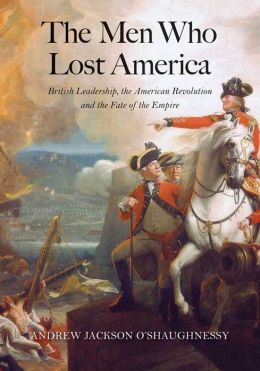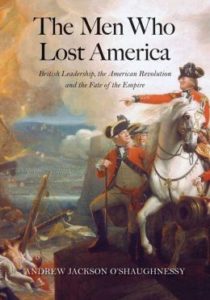The Art of Losing

“I lost two cities, lovely ones. And, vaster,
some realms I owned, two rivers, a continent.
I miss them, but it wasn’t a disaster.”
—Elizabeth Bishop, “One Art”
Four decades ago, Bernard Bailyn suggested that histories of the American Revolution were entering their “tragic” phase: that is, the era in which both sides in the conflict—winners and losers, patriots and loyalists—could be depicted in a fair and even-handed way. From his biography of Thomas Hutchinson and Carol Berkin’s contemporaneous treatment of Jonathan Sewall to the recent appearance of books by Thomas B. Allen, Maya Jasanoff, and Ruma Chopra, it appears that the loyalists of eighteenth-century British North America have finally begun to get their due.
The same cannot be said of the men who led Britain’s effort to defeat the independence movement. Historians have expended little energy to validate the judgments of King George III or the ministers—Lord North, Lord Germain, the Earl of Sandwich—who crafted policy in those years. More attention has been given to the military commanders who led the war effort, but the Howe brothers, Burgoyne, Clinton, and Cornwallis have been criticized for their failures of judgment much more often than they have been dealt with sympathetically.
Andrew Jackson O’Shaughnessy’s marvelous new book, The Men Who Lost America, redresses this failing and, in the process, gives us the kind of three-dimensional treatment of Britain’s role in the American Revolution that we have long needed. At least since the era of the Vietnam War, most historians have treated the military outcome of the American Revolution as a foregone conclusion: if Vietnam taught Americans the lesson that an invading army cannot suppress a homegrown insurgency, no matter how disproportionate the combatants’ resources appear to be, U.S. historians have come to view the American Revolution as the first and greatest demonstration of that principle.
Paradoxically, O’Shaughnessy argues that Britain lost the war for America in a four-week period in 1776 (86-87), yet he nevertheless succeeds in restoring a profound sense of contingency to his narrative and analysis of events. His book takes the form of nine biographical chapters, each of which considers a key architect of British policy or strategy (one chapter treats both of the Howe brothers, so ten individuals are profiled). Beginning with chapters on George III and Lord North, and thereby offering a political overview of the war effort, he proceeds to depict five commanding officers and three more political figures whose choices did much to shape British action during the era of the American Revolution. While O’Shaughnessy is always willing to criticize the men he profiles and to highlight the ways in which their personalities shaped their choices for better and worse, his treatments are consistently generous. He succeeds brilliantly in humanizing his cast of characters and allowing the reader to see the constraints under which they worked. The biographical structure means that the book’s chapters overlap chronologically, but instead of redundancy we get an increasingly complex and layered perspective on a set of linked problems.
One kind of payoff this book offers is a reassessment of crucial political and strategic questions that many previous historians have puzzled over. Though Americans tend to think of George III as a tyrant, intransigent in his unwillingness to mediate the conflict between Parliament and the colonies, O’Shaughnessy restores the mood of optimism that attended his ascension to the throne and highlights the ways in which he sought to restrain the Parliamentary impulse to take a hard line with the colonies. Yet in the wake of the Boston Tea Party, George III “strongly endorsed” the Coercive Acts, and once committed to the use of force he was unwavering in his resolve (22). The instrument of his policy, Lord North, was as ineffectual a war leader as one could possibly imagine—yet since he never accepted the title of prime minister, and from 1777 onward tried to persuade the king that the war was unwinnable, this is perhaps unsurprising. George refused to listen to North, but wouldn’t replace him either, and North’s ambivalent leadership created a weak and divided cabinet. The British war effort was often confused and sometimes in disarray, and O’Shaughnessy makes clear that this was a problem that began at the top.
The Howe brothers embodied the problem. General William Howe and Admiral Richard Howe were both members of Parliament who were sympathetic to the colonies and unsure about American policy before the war. Once the fighting began, they were sent to North America with dual roles, simultaneously holding military commands and appointments as peace commissioners. General Howe was an extremely capable commander-in-chief, yet his judgments were repeatedly clouded by miscalculations about both the strength of the colonies’ military forces, which he tended to underestimate, and the attitudes of its civilian population, which he assumed ran much more strongly toward loyalism than they did.
Nowhere was this fatal combination more evident than in Howe’s decision, in the summer of 1777, to march on Philadelphia rather than assisting Burgoyne’s attempt to capture the strategic corridor that ran from the St. Lawrence Valley up the Richelieu River and through Lakes Champlain and George into the Hudson Valley. No objective in the northern colonies was more vital than this corridor, control of which would have cut New England off from the colonies to the south and assured Britain of a secure line of communication between Canada and New York. Instead, Howe marched on Philadelphia and left Burgoyne to his own devices. He captured the city in late September, only a few weeks before Burgoyne was forced to surrender at Saratoga.
Burgoyne’s defeat made Howe’s decision appear tantamount to malfeasance and led to a Parliamentary inquiry into his conduct. But O’Shaughnessy contends that the lack of coordination between Howe and Burgoyne was the result of neither willful disregard of duty nor a breakdown in communication, so much as it derived from Howe’s unrealistic expectation that the two initiatives could succeed independent of each other.
Burgoyne has been one of the principal scapegoats for Britain’s military failure in North America for more than 200 years, but O’Shaughnessy rescues him from derision and allows us to see events unfold from the general’s perspective. Often caricatured as a vain aristocrat whose personal baggage nearly outweighed his regiment’s ordnance, Burgoyne, “the least aristocratic of the British commanders in America,” is shown by O’Shaughnessy to have been an enlightened and ambitious military reformer, progressive in his attitudes, insightful in his judgments, and successful in the field (124). Like Howe, his greatest mistake was to underestimate the popularity of the Revolutionary cause.
Another strength of the book is to illuminate forgotten or underappreciated dimensions of the Revolution. Thus, for example, O’Shaughnessy’s account of Germain’s attempt in 1779 to shift the theatre of the war to the Caribbean basin and to conquer Spain’s American colonies through a Central American campaign. Conceived and led by Major General John Dalling, the governor of Jamaica, the plan relied on the support of Miskito Indians and the deployment of irregular forces. Plagued by bad leadership and—literally—by tropical disease, the expedition collapsed and came to nothing, while diverting badly needed manpower and attention from the Gulf Coast, where Britain eventually surrendered West Florida to the Spanish (yellow fever and malaria crippled every European army that attempted to fight in the American tropics in the eighteenth and nineteenth centuries, as J. R. McNeill has brilliantly argued in Mosquito Empires).
In the end, O’Shaughnessy demonstrates that weak political leadership in London hamstrung British military leadership across the Atlantic, but also that the war effort failed “not as a result of incompetence and blundering, but because of insufficient resources, the unanticipated lack of loyalist support, and the popularity of the Revolution” (353). And he emphasizes that the war was far from a total loss: “The men who lost America were also the men who saved Canada, India, Gibraltar, and the British Caribbean” (361). Most of the men O’Shaughnessy profiles continued to play important roles in the army, in Parliament, and in imperial administration after the American war. None was more noteworthy than Cornwallis, who—after surrendering to Washington at Yorktown—succeeded Warren Hastings as governor general of Bengal, where he led an army of 20,000 to victory in the Third Mysore War. Then he served as lord lieutenant of Ireland and defeated an invading French army during the great rebellion of 1798.
Readers often have to choose between two unsatisfactory approaches to the military history of the American Revolution. Non-military historians tend to skate over the surface of events, providing too little detail to make the subject interesting or meaningful. Military historians are prone to err in the opposite direction while, with the aid of hindsight, criticizing every false step a war leader makes. The genius of this book lies in O’Shaughnessy’s sympathetic engagement with the experiences, aspirations, and shortcomings of his characters. He evinces no desire either to second-guess the decisions they made or to re-fight the battles of the Revolution to produce a different outcome. This is tragic history in the truest sense, an act of recovery and restoration that seeks to humanize an extraordinary cast of characters and do justice to the vast, complex, doomed effort to prevent American independence.
This article originally appeared in issue 15.1 (Fall, 2014).
Eric Hinderaker is professor of history at the University of Utah. He is currently working on a history of the Boston Massacre.
